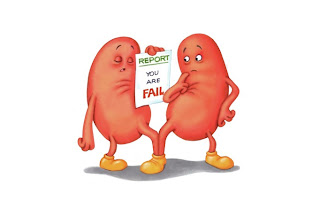
Hydronephrosis
Definition
Hydronephrosis is the swelling of the kidneys when urine flow is obstructed in any of part of the urinary tract. Swelling of the ureter, which always accompanies hydronephrosis, is called hydroureter. Hydronephrosis implies that a ureter and the renal pelvis (the connection of the ureter to the kidney) are overfilled with urine.
Description
The kidneys filter urine out of the blood as a waste product. It collects in the renal pelvis and flows down the ureters into the bladder. The ureters are not simple tubes, but muscular passages that actively propel urine into the bladder. At their lower end is a valve (the ureterovesical junction) that prevents urine from flowing backward into the ureter. The bladder stores urine. The prostate gland surrounds the bladder outlet in males. Urine then flows through the urethra and out of the body as a waste product.
Because the urinary tract is closed save for the one opening at the bottom, urine cannot escape. Instead, the parts distend. Rupture is rare unless there is violent trauma like an automobile accident.
Obstructed flow anywhere along the drainage route can cause swelling of the upper urinary tract, but if the obstruction is below the bladder, the ureterovesical valve will protect the upper tract to a certain extent. Even then, with no place to go, the urine will back up all the way to its source. Eventually, the back pressure causes kidney function to deteriorate.
Obstruction need not be complete for problems to arise. Intermittent or partial obstruction is far more common than complete blockage, allowing time for the parts to enlarge gradually. Furthermore, if a ureterovesical valve is absent or incompetent, the pressure generated by bladder emptying will force urine backward into the ureter and kidney, causing dilation even without mechanical obstruction.
Causes and symptoms
Causes are numerous. Various congenital deformities of the ureter may sooner or later produce back pressure. Kidney stones are a common cause. They form in the renal pelvis and become lodged in the kidney, usually at the ureterovesical junction. In older men, the continued growth of the prostate gland leads commonly to restricted urine flow out of the bladder. Prostate cancer, and cancer anywhere else along the urine pathways, can obstruct flow. Pregnancy normally causes ureteral obstruction from the pressure of the enlarged uterus (womb) on the ureters.
Symptoms relate to the passage of urine. Sometimes, urine may be difficult to pass, irregular, or uncontrolled. Pain from distension of the structures is present. Blood in the urine may be visible, but it is usually microscopic.
In all cases where bodily fluids cannot flow freely, infection is inevitable. Symptoms of urinary infection may include:
- painful, burning urine
- cloudy urine
- pain in the back, flank, or groin
- fever, sweats, chills, and generalized discomfort
Patients often mistake a serious urinary infection for the flu.



